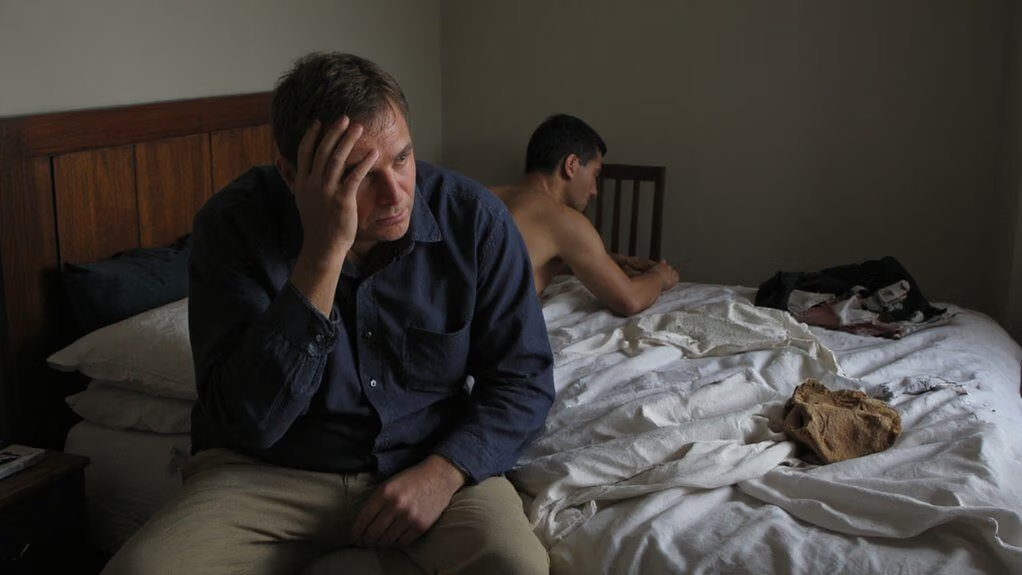You’ll notice sexual changes—reduced libido, fewer nocturnal erections—and physical shifts like decreased muscle mass, increased central adiposity, diminished body and facial hair, and smaller testes. Mood, cognition, bone density, and metabolic markers can also be affected. You should check morning testosterone and reversible causes; next, we’ll outline key signs, diagnostic thresholds, and management.
Common Physical Symptoms of Low Testosterone

Many men with low testosterone present with a characteristic cluster of physical signs and symptoms. You’ll often note progressive sarcopenia with reduced lean mass and strength, elevated adiposity especially central distribution, and impaired recovery after exertion. You may exhibit decreased bone mineral density, increasing fracture risk, and laboratory evidence of normocytic anemia in some cases. Cutaneous and hair changes include reduced facial and body hair and thinning scalp hair. Testicular atrophy with lowered testicular volume and firmness is common. Energy metabolism shifts—insulin resistance markers and dyslipidemia—are frequently associated. Objective assessment requires serial morning total and free testosterone measurements, LH/FSH profiling, hematocrit, and DXA scanning for bone density. You should correlate signs with labs before initiating targeted endocrine interventions and pursue individualized, mechanism-based therapeutic algorithms.
Sexual Health Changes to Watch For

You may experience reduced libido, a common symptom correlated with low serum testosterone levels. Low testosterone also increases your risk of erectile dysfunction via hormonal modulation of endothelial, neural, and cavernosal function. You’ll often notice fewer spontaneous nocturnal or morning erections, which can be quantified with nocturnal penile tumescence testing.
Reduced Sex Drive
How does reduced libido present in men with hypogonadism? You’ll typically report diminished sexual desire, fewer spontaneous sexual thoughts, and decreased initiation of sexual activity. Objective assessments correlate low serum testosterone with lower scores on validated libido scales (e.g., Sexual Desire Inventory). Neuroendocrine mechanisms include reduced androgen receptor activation in limbic and hypothalamic circuits, altering dopaminergic modulation of sexual motivation. Clinical evaluation should quantify symptom severity, temporal onset, comorbid depression, medication effects, and concomitant metabolic or sleep disorders that confound causality. Hormone assays taken morning and repeated can confirm biochemical hypogonadism. Management considerations involve evidence-based testosterone replacement when indicated, monitoring hematocrit and prostate parameters, and integrating behavioral or psychosexual interventions. You’ll expect measurable improvements in desire within weeks to months if treatment is appropriate.
Erectile Dysfunction Risk
Although erectile dysfunction (ED) in men with hypogonadism often reflects multifactorial pathology, reduced serum testosterone contributes directly and indirectly to impaired erectile function through decreased nitric oxide synthase activity, altered cavernosal smooth muscle structure, and diminished sexual motivation. You should recognize that low testosterone modulates endothelial function, reduces penile blood flow reserve, and alters neurotransmitter signaling implicated in erection physiology. Diagnostic evaluation should integrate hormonal assays with vascular studies and validated ED questionnaires to delineate endocrine versus vascular etiologies. Therapeutic strategies can include testosterone replacement therapy when indicated, phosphodiesterase type 5 inhibitors, and targeted vascular or neuromodulatory interventions. You should monitor response objectively with penile Doppler metrics, nocturnal tumescence adjuncts, and standardized outcome measures to guide precision treatment. Adjust therapy based on biomarkers regularly.
Fewer Spontaneous Erections
Fewer spontaneous erections—particularly reductions in nocturnal or early-morning tumescence—signal a measurable change in erectile physiology that often accompanies low testosterone but can also reflect vascular, neurologic, or medication-related causes. You should monitor frequency, rigidity, and duration objectively—home nocturnal penile tumescence testing or validated questionnaires can quantify decline and differentiate hypogonadal from psychogenic etiologies. Biochemical correlation requires morning total and free testosterone with SHBG, repeated to confirm hypogonadism, and adjunctive evaluation of vascular flow (Doppler ultrasound) and neurologic integrity when indicated. Review concurrent drugs (SSRIs, antihypertensives) and comorbidities (diabetes, atherosclerosis). If low testosterone is confirmed, evidence-based interventions include optimized lifestyle, targeted testosterone replacement therapy with monitoring, and integration of novel modalities under clinical trial protocols when standard therapies fail to maximize functional and metabolic outcomes.
Emotional and Cognitive Signs

Mood disturbance is a common manifestation of testosterone deficiency; clinical studies show men with low serum testosterone are more likely to report irritability, depressed mood, reduced motivation and diminished well‑being, and they’re more likely to demonstrate impairments in attention, verbal memory and executive function on standardized cognitive tests. You may notice subtle changes in mood regulation, decreased drive, and slower processing speed that correlate with hormone concentration. Neuropsychological profiling and neuroimaging studies associate these deficits with androgen receptor distribution in hippocampal and prefrontal cortex alterations. When you report these symptoms, clinicians should quantify morning total testosterone, free testosterone and perform mood and cognitive scales. Emerging therapeutic strategies, including targeted androgen replacement and interventions, aim to restore neuropsychological function while monitoring metabolic and cardiovascular metrics.
Risk Factors and Who’s Most Likely to Be Affected
You should be aware that both modifiable lifestyle factors and underlying medical conditions substantially increase the risk of low testosterone. Obesity, sedentary behavior, excessive alcohol use, and some medications are common lifestyle-related contributors documented in epidemiological studies. Chronic illnesses such as type 2 diabetes, metabolic syndrome, pituitary or testicular dysfunction, and systemic inflammatory disorders also raise probability and warrant targeted evaluation.
Lifestyle Factors
Modifying lifestyle factors substantially alters serum testosterone concentrations and contributes to hypogonadism risk via metabolic, endocrine, and inflammatory pathways. You should prioritize body composition optimization, sleep hygiene, nutrition quality, and physical activity because they modulate hypothalamic–pituitary–gonadal axis output. Targeted interventions that reduce visceral adiposity and insulin resistance elevate circulating testosterone; structured resistance training and adequate caloric-protein balance support androgen synthesis. Conversely, chronic sleep restriction, excessive alcohol intake, and persistent psychosocial stress suppress gonadotropin secretion and increase inflammatory cytokines. Implement iterative, measurable strategies and track biomarkers to guide innovation in personalized lifestyle prescriptions.
- Weight management: reduce visceral fat to improve SHBG and free testosterone.
- Exercise: progressive resistance plus high-intensity intervals.
- Sleep and recovery: prioritize 7–9 hours, treat sleep apnea.
You should monitor outcomes and iterate.
Medical Conditions
Although multiple chronic and acute medical conditions impair hypothalamic–pituitary–gonadal function, clinicians should recognize a predictable set of disorders that substantially increase the risk of male hypogonadism. You should screen patients with obesity, type 2 diabetes mellitus, metabolic syndrome, and obstructive sleep apnea because adiposity-related insulin resistance and systemic inflammation suppress gonadotropin secretion and reduce circulating testosterone. You should also assess men with pituitary adenomas, hemochromatosis, chronic kidney disease, HIV, and chronic glucocorticoid exposure, as primary or secondary gonadal failure can result. Prioritize evaluation in men with testicular trauma, mumps orchitis, or prior chemotherapy/radiation. Use targeted biochemical testing (total and free testosterone, LH, FSH, prolactin, iron studies) and imaging when indicated. Early identification lets you tailor hormone or disease-specific interventions and novel therapeutic strategies effectively.
How Low Testosterone Is Diagnosed
Diagnosis of low testosterone relies on targeted clinical assessment plus confirmatory laboratory testing. You obtain a directed history (sexual function, energy, mood, medications), perform focused exam including testicular size and body composition, and use validated symptom scales. Biochemical confirmation needs morning total testosterone on two occasions with standardized assays; calculate free testosterone if SHBG is abnormal. Assess gonadotropins and prolactin to localize pathology; reserve pituitary MRI for central causes.
- Laboratory testing: two morning totals, SHBG, calculated free testosterone, LH/FSH, prolactin.
- Clinical evaluation: structured history, validated questionnaires, focused physical examination.
- Imaging and referral: pituitary MRI for low LH/FSH or mass suspicion; endocrine consultation for atypical results.
You must integrate laboratory precision, assay limitations, and patient-specific factors, then document rationale and share management plan with specialists.
Treatment Options and Lifestyle Strategies
When you confirm clinically significant testosterone deficiency and rule out reversible causes, treatment combines evidence-based medical therapies with targeted lifestyle interventions to optimize symptoms, metabolic health, and fertility goals. You’ll evaluate indications for testosterone replacement therapy (TRT) versus conservative management based on symptom severity, comorbidities, and reproductive intent. If you choose TRT, options include transdermal gels, intramuscular injections, subcutaneous pellets, and nasal preparations, each with pharmacokinetic trade-offs; monitor hematocrit, PSA, lipids, and bone density. For fertility preservation, consider selective use of hCG, clomiphene citrate, or aromatase modulation. Concurrently, implement evidence-based lifestyle strategies: resistance training, optimized sleep, weight reduction, alcohol moderation, and dietary protein distribution. Use data-driven monitoring and adjust interventions iteratively. Engage multidisciplinary specialists and integrate emerging technologies for personalized therapeutic optimization pathway insights.
Conclusion
You should recognize that low testosterone commonly impairs libido, sexual function, muscle mass, mood, and metabolic profile; you’ll need morning serum total testosterone confirmed on repeated testing and assessment for reversible causes. If biochemical deficiency and clinical symptoms coexist, you and your clinician can evaluate risks/benefits of testosterone therapy, monitor hematocrit, PSA, lipids, and bone density, implement lifestyle interventions (weight loss, resistance training, sleep optimization), and reassess therapy efficacy and safety.